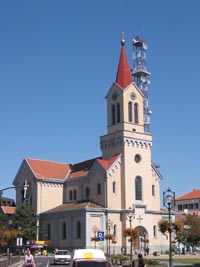 Zrenjanin
Zrenjanin
It is said that there is no town in Serbia with as many bridges as Zrenjanin. Some say there are more than twenty of them – big and small, made of concrete or metal, suspension bridges and any other kinds you could possibly think of.
Town Square with baroque Town Hall, extraordinary red roofed Cathedral and pedestrian street that is the main artery of the Old Town, as well as the palace of today's Court and the slowly decaying Reformation Gothic Church are some of the things that may attract your attention while walking in downtown Zrenjanin.
If you have extra time in Zrenjanin, it is worth spending a couple of hours on an excursion to Echka Castle, which is covered on this website as a separate destination.
{tab=history}
History of Zrenjanin
The oldest written information about Zrenjanin, once called Veliki Beckerek, originates from the 14th century. Zrenjanin was at the time a large village populated mostly by Hungarian peasant. In the late 14th century, first Serbian settlers came from the south.
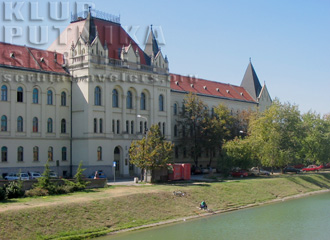 In 1403, Veliki Beckerek came into possesion of Serbian despot Stefan Lazarevic, who fought against the Turks as a Hungarian vassal.
In 1403, Veliki Beckerek came into possesion of Serbian despot Stefan Lazarevic, who fought against the Turks as a Hungarian vassal.
In 1551 the Turks, led by Mehmed-Pasha Sokolovic, conquered the town. It stayed under Ottoman rule until it was liberated by the Austrian army in 1717, commanded by prince Alexander of Virtemberg.
After the World War I, in 1918, Beckerek, as well as the whole region of Vojvodina, became a part of the Kingdom of Serbs, Croats and Slovenes.
Soon after the WW II, in 1946, the town’s name was changed to Zrenjanin, after national hero Zarko Zrenjanin.
{tab=getting there}
Getting to Zrenjanin
Zrenjanin has good road links with Novi Sad, Belgrade, Subotica, Kikinda, Vrsac, Timisoara in Romania, etc.
The easiest way to reach Zrenjanin is on a bus from Novi Sad. There are around fifteen departures on workdays and fewer on weekends.
You can also come to Zrenjanin by bus from Vrsac. There are seven daily buses.
Zrenjanin Bus Station phone no: 023 / 541-000
There are two daily trains operating between Novi Sad and Zrenjanin. The trip takes less than two hours.
From Kikinda to Zrenjanin there are three daily trains. The trip takes two hours.
There are four daily trains from Vrsac to Zrenjanin.
Zrenjanin Railway Station phone no: 023 / 530-388
{tab=things to see}
What to see in Zrenjanin?
The heart of Zrenianin is Trg Slobode square, dominated by the Town Hall. It was built in 1820 according to the plans of the architect Josip Fisher. In front of the Town Hall you can see one of the symbols of the town - a hundred years old yew tree.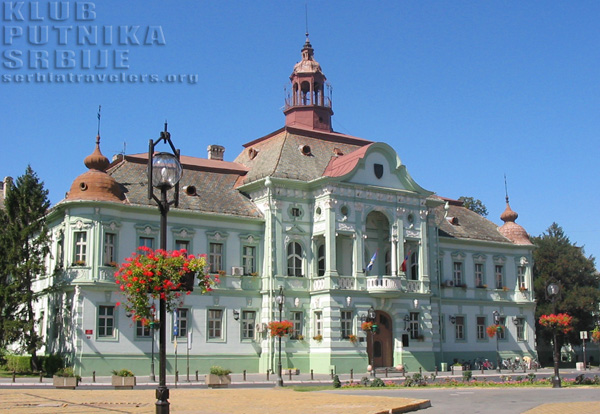
On the Trg Slobode there is a Catholic Church famous for its Clock Tower and red roof. The Church was built in 1868 in Neo-Romanesque style following the plans of the architect Stefan Djordjevic. Internal decoration was made by Jozef Geugner, after the already existing sketches by French graphic artist Gustav Dorés. The piece of special interest is the reproduction of Da Vinci’s “Last Supper”.
At the beggining of the street leading from Trg Slobode and passing by Vojvodina Hotel, there is a Piaristic Church, built in 1846 by Piaristic Clergy (Orto Scholarum Piarum). The yellow Neo-Romanesque Church building today belongs to the Grammar School complex. 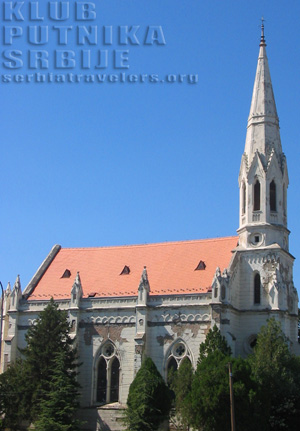 From the Town Square, a large pedestrian street Kralja Aleksandra begins, standing for the oldest and the most beautiful street in Zrenjanin with a number of interesting buildings from different epochs. The house of stonecutter Tuner Teodosije built in 1900 in unusual Moorish style, and therefore called "Seherezada", will no doubt catch your eye.
From the Town Square, a large pedestrian street Kralja Aleksandra begins, standing for the oldest and the most beautiful street in Zrenjanin with a number of interesting buildings from different epochs. The house of stonecutter Tuner Teodosije built in 1900 in unusual Moorish style, and therefore called "Seherezada", will no doubt catch your eye.
If you take King Aleksandar Street, you will come to Republic Square and, on your right side, you will see the tower of Assumption Church in St. Sava Street, built in 1746 in baroque style, typical of churches in Vojvodina. It was painted by Aleksandar Sekulic in 1924.
If you take Suboticka Street from the Town Hall, you will come to a small green bridge made of metal. When you cross it, you will come to the Court, one of the most beautiful buildings in Zrenjanin. It was built in 1908 according to the project of architects from Budapest, and looks like a palace. The central part of the building has two small towers, while the bigger ones are at the corners.
The Reformation Church built in 1891 in pure gothic style is located just next to the Court building. The church is whitewashed and in a very bad shape, but still very interesting for its gothic style that contrasts the architecture of this region. The architect's name was Zabonecki’s. A large pipe organ, moved from the demolished Synagogue, is kept there. 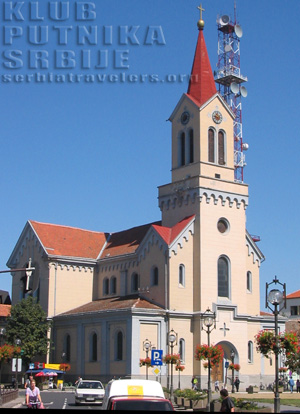 Museums and galleries
Museums and galleries
National Museum (Suboticeva 1, tel. 023/ 61 - 841 i 023/ 34-020, opene 8-18 on workdays, 8-13 on Saturday, closed on Sunday; open 8-14 in summer) is situated in the former Financial Palace, built in 1894 and designed by architect Istvan Kish. It comprises five sections- Natural history, Ethnological, Archeological, Artistic and Historical. In natural history section exhibits from botanical and zoological collections can be seen. Ethnological collection consists of home furniture, nathional costumes, agricultural hand tools, livestock handling equipment and craftworks made in Middle Banat region. Archeological section houses more than 10,000 items from prehistoric times to late Middle Ages. Artistic section includes an exhibition of works of Vojvodina's painters from 1700 on, applied arts, period furniture, glass, metal, pocelain. Historical section consists of three collections - around 950 items from the ancient times, objects related to the People’s Liberation War and an excelent numismatics collection.
Contemporary Art Gallery (Trg Slobode Square 7, tel. 023/ 562-566, 023/ 562-593, 023/ 561-775; opened 8-19 on workdays, 9-13 on Saturdays; www.galerija.rs ) houses more than 2,000 paintings, mostly post-WWII art.

